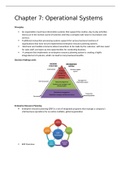Summary
Summary Chapter 7 Operational systems
- Module
- Institution
- Book
INF112 Chapter 7 Operational Systems Defines enterprise resource planning, the advantage, and disadvantages. The Transaction Processing Systems, the types thereof - ordering, purchasing, accounting. electronic and mobile commerce Customer Relationship Management and sales orders financi...
[Show more]




